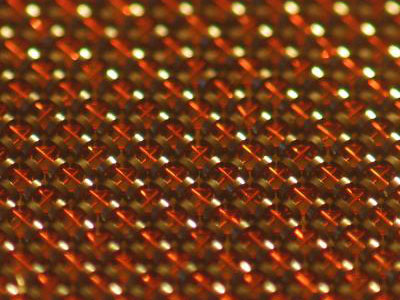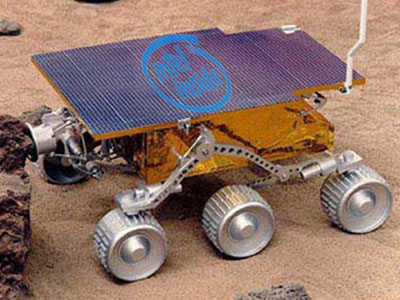
Less power is good for cooling too. Just as making sure components don’t cook themselves down here on the third rock is an issue, it is as much – if not more – of one upstairs. If your power hungry system generates a great deal of heat, how do you get rid of it? Heat doesn’t tend to rise in a weightless environment, so you’re going to need to some method to remove that heat - fans, liquid cooling etc. But forget about any fancy light effects on those, due to the power restrictions.
And of course, any heat that’s pumped into the cabin by said cooling systems will need to be ultimately radiated away some how - or the spacecraft will soon become an orbital oven, slowly cooking the occupants. This is usually achieved via large radiator panels, which of course adds to the weight and complexity of the spacecraft. It’s also an issue on unmanned craft as well – heat needs to be dumped, lest you want grilled systems.
As you're all aware computers don't just operate on data plucked from thin air. They also need to read and write information as well as process it - which means some form of persistant large scale storage. But you’ll rarely find a modern spacecraft with a multi gigabyte hard drive on board – as they don’t work in a vacuum. In fact, the most common secondary storage medium is the humble tape drive - although more modern methods are starting to be adopted. Cassini, currently in orbit around Saturn is the first probe to employ completely solid state recorders / secondary storage for science data.

Cassini, boldly going.
Primary 'working' storage is usually equally as archaic, as it often takes the form of magnetic core memory – as it is radiation proof, and non-volatile – which makes it an excellent choice for spacecraft applications.

Core store is made up of thousands of ferrite doughnuts

Ummm.... ferrite doughnuts
Speaking of radiation, it’s another big headache for spacecraft system designers to combat. Whilst core store is a good solution on the memory front, when it comes to ‘hardening’ CPUs and other microelectronics against the effects of the various sources of space-borne radiation it’s a case of keeping them simple again. The lower the component count on a chip (and hence dumber it is), the less susceptible it is to radiation. Bipolar transistors are also used in these components, as they are inherently more radiation proof.
An example of these hardened processors are those onboard the seemingly tireless Mars Exploration Rovers, Spirit and Opportunity. The two of them are controlled with a hardened version (The RAD6000) of IBM’s early, low powered Power CPU – which of course was the granddaddy of the PowerPC line of processors. Their smaller brother, Pathfinder also used hardened hardware, but it used a CMOS version of the antiquated Intel 8085.

Ding ding - ding dong...
I’ve yet to discover any spacecraft that employs AMD hardware…
Having said that keeping it simple and using specialised equipment is the way to go, there are people that are building spacecraft and rockets that are running counter to this status-quo. An increasing number of Individuals, and non-governmental groups and companies are using off the shelf components in the quest to get into space – a lot of the guys involved in the X-Prize used standard computer components in their designs – although maybe it’s telling that the winning SpaceShipOne had custom built avionics (and whilst Paul Allen was the money man, it didn’t run XP).
Others using this off the shelf approach are the institutions building Pong or Cube satellites – as these components are cheap, and the application that they are put to only calls for hours, or maybe days of use. And it’s not only off the shelf components these guys are using – flight software is being written and run in Linux by some of the more serious rocketry amateurs.
But these experimental craft are showing that modern equipment is more resilient to the extreme environment of space than people have been led to expect. So it may be that some day in the not too distant future, you’ll be able to have a quick game of Half-Life 3 with a decent frame rate whilst staying at an inflatable orbital ‘Budget Hotel’.
Some further reading:
Nasa History of Computers in Manned Spaceflight
Nasa History of Computers in Unmanned Spaceflight
The Encyclopedia Astronautica
And of course, any heat that’s pumped into the cabin by said cooling systems will need to be ultimately radiated away some how - or the spacecraft will soon become an orbital oven, slowly cooking the occupants. This is usually achieved via large radiator panels, which of course adds to the weight and complexity of the spacecraft. It’s also an issue on unmanned craft as well – heat needs to be dumped, lest you want grilled systems.
As you're all aware computers don't just operate on data plucked from thin air. They also need to read and write information as well as process it - which means some form of persistant large scale storage. But you’ll rarely find a modern spacecraft with a multi gigabyte hard drive on board – as they don’t work in a vacuum. In fact, the most common secondary storage medium is the humble tape drive - although more modern methods are starting to be adopted. Cassini, currently in orbit around Saturn is the first probe to employ completely solid state recorders / secondary storage for science data.

Cassini, boldly going.
Primary 'working' storage is usually equally as archaic, as it often takes the form of magnetic core memory – as it is radiation proof, and non-volatile – which makes it an excellent choice for spacecraft applications.

Core store is made up of thousands of ferrite doughnuts

Ummm.... ferrite doughnuts
Speaking of radiation, it’s another big headache for spacecraft system designers to combat. Whilst core store is a good solution on the memory front, when it comes to ‘hardening’ CPUs and other microelectronics against the effects of the various sources of space-borne radiation it’s a case of keeping them simple again. The lower the component count on a chip (and hence dumber it is), the less susceptible it is to radiation. Bipolar transistors are also used in these components, as they are inherently more radiation proof.
An example of these hardened processors are those onboard the seemingly tireless Mars Exploration Rovers, Spirit and Opportunity. The two of them are controlled with a hardened version (The RAD6000) of IBM’s early, low powered Power CPU – which of course was the granddaddy of the PowerPC line of processors. Their smaller brother, Pathfinder also used hardened hardware, but it used a CMOS version of the antiquated Intel 8085.

Ding ding - ding dong...
I’ve yet to discover any spacecraft that employs AMD hardware…
Having said that keeping it simple and using specialised equipment is the way to go, there are people that are building spacecraft and rockets that are running counter to this status-quo. An increasing number of Individuals, and non-governmental groups and companies are using off the shelf components in the quest to get into space – a lot of the guys involved in the X-Prize used standard computer components in their designs – although maybe it’s telling that the winning SpaceShipOne had custom built avionics (and whilst Paul Allen was the money man, it didn’t run XP).
Others using this off the shelf approach are the institutions building Pong or Cube satellites – as these components are cheap, and the application that they are put to only calls for hours, or maybe days of use. And it’s not only off the shelf components these guys are using – flight software is being written and run in Linux by some of the more serious rocketry amateurs.
But these experimental craft are showing that modern equipment is more resilient to the extreme environment of space than people have been led to expect. So it may be that some day in the not too distant future, you’ll be able to have a quick game of Half-Life 3 with a decent frame rate whilst staying at an inflatable orbital ‘Budget Hotel’.
Some further reading:
Nasa History of Computers in Manned Spaceflight
Nasa History of Computers in Unmanned Spaceflight
The Encyclopedia Astronautica

MSI MPG Velox 100R Chassis Review
October 14 2021 | 15:04






Want to comment? Please log in.